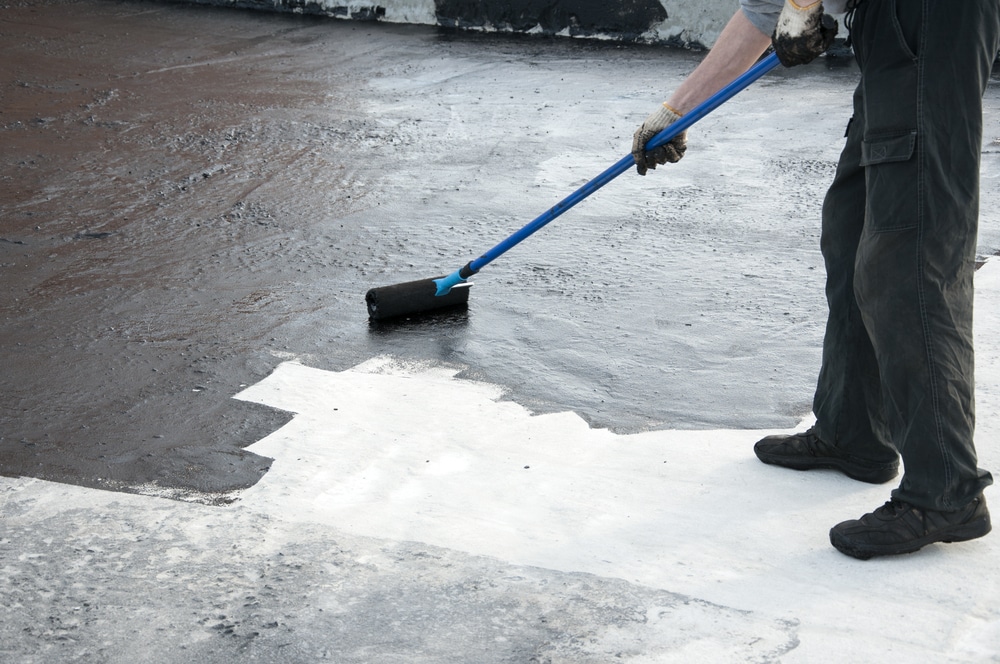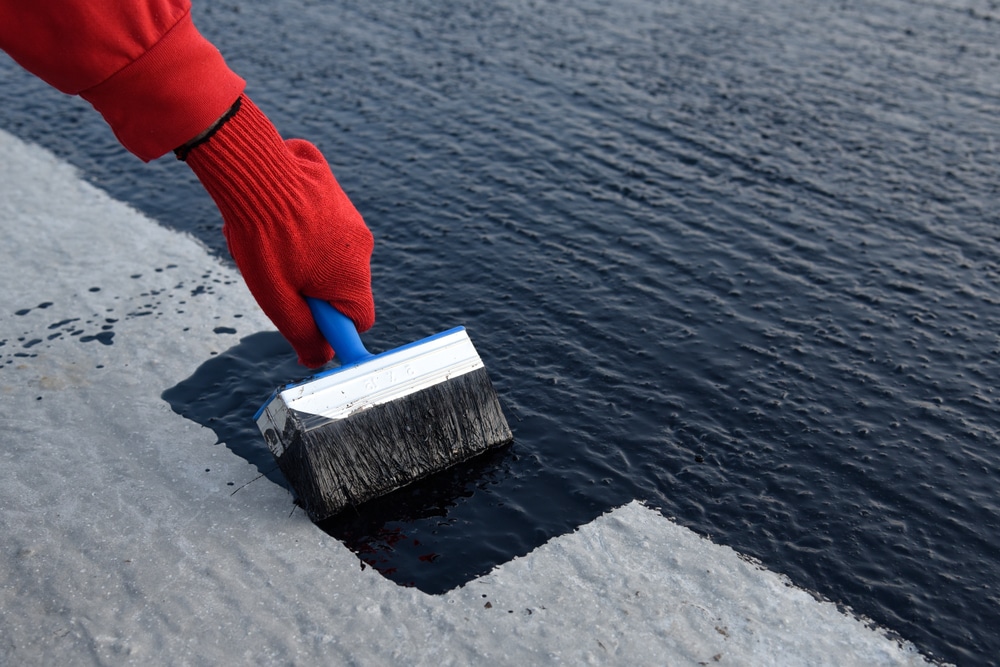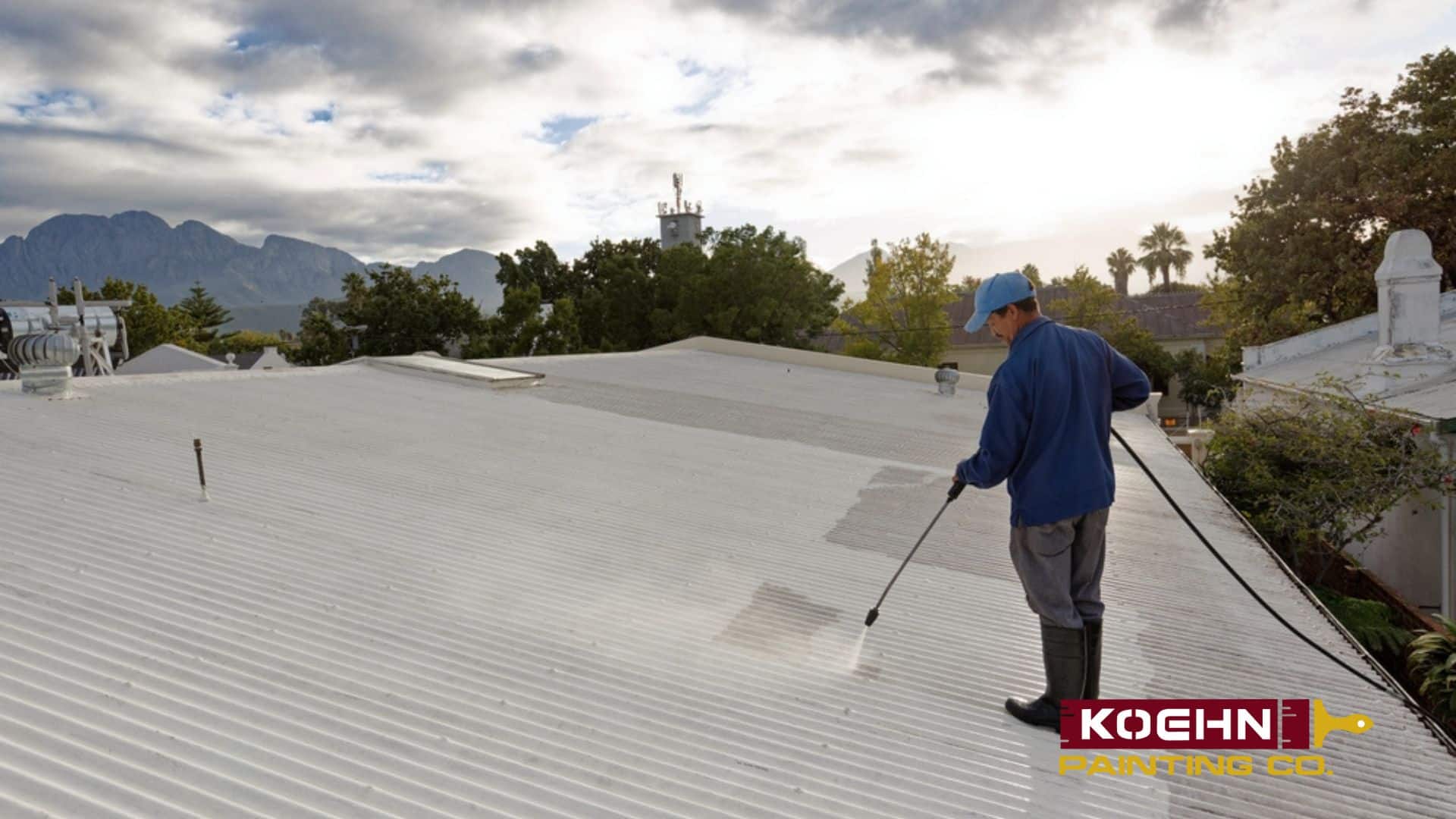Table of Contents
ToggleWhen was the last time you scheduled a commercial roof painting service for your business? For most business owners, the answer is likely “not recently,” and that’s understandable. Roofs are easy to overlook—until they start causing problems.
Leaks, energy inefficiencies, and unexpected repair bills have a funny way of showing up at the worst possible time. But what if you could extend the life of your roof, reduce long-term costs, and improve your building’s performance—all without the massive expense of a full replacement?
Commercial roof painting and roof coating services aren’t just aesthetic or cosmetic matters. A professionally applied roof coating system is a high-performance protective layer designed to safeguard your investment, prevent premature damage, and even cut down on utility costs.
Studies show that reflective roof coatings can reduce surface temperatures by up to 50°F and lower building cooling energy use by as much as 15%—which adds up fast if you’re running a warehouse, office, or industrial facility.
And here’s the best part: roof coatings are one of the most cost-effective, low-disruption solutions available for commercial roof maintenance—no tear-offs or full shutdowns, just smart protection that works.
But let’s start from the beginning with what commercial roof painting really is—and why more smart business owners are turning to it as their go-to maintenance strategy.
What Is Commercial Roof Painting?
Commercial roof painting is the process of applying a specialized protective coating to the surface of a commercial roof. But don’t let the word “painting” fool you—this isn’t your typical paint job. We’re talking about industrial-grade coatings engineered to extend the life of your roof, improve performance, and provide a barrier against the elements.
These coatings aren’t just sprayed on for looks. They’re formulated to adhere, seal, reflect, and protect—all while helping you avoid costly replacements down the line. Depending on the type of roof and the product used, commercial roof coatings can provide protection for 10, 15, even 20 years with proper maintenance.
That’s the “what.” But the real value lies in the why. Why are more business owners choosing roof coatings over full replacements? Why do facilities managers keep them on their preventative maintenance radar?
When done right, commercial roof painting delivers far more than just surface-level protection—it offers a wide range of practical, financial, and operational benefits that make it one of the smartest investments you can make for your building.
Let’s break those down.
The Benefits of Commercial Roof Painting
Commercial roof painting delivers real, measurable value when it comes to protecting your building and your bottom line. It’s a strategic investment move that pays off in performance, efficiency, and long-term savings.
Here’s what you get when you invest in a professional roof coating system:
1. Extended Roof Lifespan
A quality roof coating acts like armor for your building. It seals and protects the existing surface, shielding it from the elements and preventing premature deterioration. That extra layer can extend your roof’s service life by 10 to 20 years, depending on the coating type and how well it’s maintained.¹
In many cases, coatings can buy you critical time—delaying the need for a costly full roof replacement and keeping your facility operational in the meantime.
2. Improved Energy Efficiency and Temperature Regulation
Reflective roof coatings—often referred to as “cool roofs”—are engineered to reduce heat absorption. By bouncing sunlight away from your building, they help keep roof surfaces cooler.
That means your HVAC system doesn’t have to work as hard, leading to energy savings of 10–15% or more, particularly during peak summer months. It’s a smart way to reduce utility costs while keeping your building more comfortable year-round.
3. Protection Against UV Rays, Water Damage, and Corrosion
Sun exposure, standing water, and weather extremes are a recipe for roofing problems. Roof coatings create a durable, weather-resistant barrier that protects against:
- UV degradation, which breaks down roofing materials over time
- Water intrusion, which causes leaks, mold, and interior damage
- Rust and corrosion, especially on metal roofs
By blocking these common culprits, coatings help preserve your roof’s structural integrity and prevent minor issues from turning into major repairs.
4. Lower Long-Term Maintenance and Repair Costs
Sadly, roof repairs are rarely budget-friendly, and emergency fixes tend to hit when you least expect them. A coating system helps you stay ahead of the curve, sealing vulnerable seams, fasteners, and flashings before they fail.
And when maintenance is needed, it’s often as simple as cleaning and recoating—far less disruptive (and expensive) than replacing sections of your roof.
5. Enhanced Aesthetic Appeal and Brand Image
First impressions matter—even when it comes to the roof. A clean, freshly coated roof can instantly improve your property’s curb appeal. Whether you’re managing a retail space, office park, or industrial facility, a well-maintained exterior signals professionalism, attention to detail, and pride of ownership—all of which reflect positively on your business.
Types of Commercial Roof Coatings

Not all commercial roof coatings are the same or work the same way, so choosing the right one can make all the difference in performance, durability, and cost-effectiveness.
The right coating depends on your roof’s material, your building’s environment, and your long-term maintenance goals. That’s why a professional evaluation is so critical before jumping into any commercial roof painting project.
Here’s a breakdown of the most common types of coatings used in commercial roof systems—and what each brings to the table.
Acrylic Roof Coatings
Acrylic coatings are one of the most widely used options in commercial roof painting. They’re water-based, cost-effective, and highly reflective—making them a great choice for improving energy efficiency.
Some of its key benefits include:
- Excellent UV resistance
- Highly reflective to reduce surface temperatures
- Easy to apply and recoat
- Best suited for sloped or pitched roofs
Acrylics are ideal for climates with more sun than rain, as they don’t hold up as well in areas with ponding water. Still, for many facilities, they strike a great balance between performance and price.
Silicone Roof Coatings
Silicone coatings are a great option for flat or low-slope roofs, especially in areas prone to heavy rainfall or ponding water. They offer unbeatable waterproofing and weather resistance.
Key benefits:
- Excellent resistance to water and ponding
- Long-lasting elasticity and flexibility
- Strong adhesion to most roofing substrates
- Minimal erosion over time
- They maintain reflectivity longer than most other coatings
Silicones do tend to attract more dirt, which can affect reflectivity over time, but they’re incredibly durable and low-maintenance—making them a solid long-term investment for many commercial roofs.
Polyurethane Roof Coatings
If your roof sees foot traffic, equipment installations, or frequent maintenance visits, polyurethane coatings offer superior durability and impact resistance.
Key benefits:
- High tensile strength and abrasion resistance
- Strong adhesion and long lifespan
- Available in both aromatic and aliphatic formulations (for base and top coats)
Polyurethane is especially effective on industrial buildings, manufacturing facilities, or roofs with heavy wear and tear.
Asphalt-Based and Rubberized Coatings
These are often used in more specialized applications, such as built-up roofing systems or modified bitumen surfaces. Rubberized asphalt coatings combine flexibility and waterproofing, making them ideal for older or non-standard substrates.
Choosing the right commercial roof coating means matching your roof’s needs with the right material, application method, and long-term performance expectations. That’s why professional commercial roof painting services include a full assessment before any coating is applied.
Applications of Commercial Roof Painting
The versatility of modern commercial roof coatings means they can be applied across a wide range of roofing systems and building types, each with its own unique challenges and demands. A manufacturing facility, a retail plaza, a sprawling warehouse complex, there’s a special coating solution to fit each roof. Let’s take a look at their differences.
Metal Roof Painting
Metal roofs are durable, but they’re far from maintenance-free. Over time, they’re prone to corrosion, UV degradation, and seam failures. A high-quality commercial roof coating can:
- Prevent rust and corrosion
- Seal fasteners and seams
- Improve thermal reflectivity to reduce indoor heat gain
- Extend the roof’s lifespan by 10+ years
Applying a specialized coating to metal roofs protects the substrate and helps reduce expansion and contraction caused by temperature swings, minimizing long-term structural stress.
Rubber and Single-Ply Roof Coatings (EPDM, TPO, PVC)
Rubber and single-ply membrane roofs are common in commercial buildings due to their flexibility and cost-effectiveness. But like any roofing system, they degrade over time—especially at seams, flashing points, and penetrations.
Coating these surfaces with compatible products (like silicone or acrylic systems) can:
- Seal seams and small punctures
- Protect against UV exposure
- Restore the membrane’s integrity without replacement
In many cases, a coating system can turn an aging single-ply roof into a renewable system—simply cleaned and recoated every decade to maintain performance.
Asphalt Roof Coatings
Built-up roofing (BUR) and modified bitumen systems are popular on low-slope commercial roofs, but they can dry out, crack, and blister as they age. Rubberized asphalt coatings or high-solids silicone systems can be applied to these surfaces to:
- Restore flexibility
- Improve waterproofing
- Reduce surface temperatures
- Prevent cracks from spreading
For building owners with legacy roofing systems, this is a highly cost-effective way to add years of service life without disrupting operations.
Waterproofing Systems and Specialty Applications
In high-moisture environments or buildings with sensitive interior operations (like food processing or electronics manufacturing), waterproofing is highly important. Commercial roof coatings play a key role in integrated waterproofing systems, sealing surfaces and preventing even micro-infiltration of moisture.
These systems often combine:
- Elastomeric coatings for flexibility
- Seam reinforcement fabrics
- Multiple layers for added durability
They’re especially valuable on roofs with complex details—parapet walls, skylights, drainage points, and HVAC penetrations—where leaks are most likely to occur.
Industry Applications
Commercial roof painting is commonly used across sectors like:
- Warehouses & Distribution Centers
- Retail Stores & Shopping Plazas
- Office Buildings
- Manufacturing Facilities
- Educational Institutions
- Healthcare Facilities
- Multi-Family Residential Complexes
Each of these building types comes with different roofing challenges—heat retention, foot traffic, moisture control, aesthetics—but the right commercial roof coating can be tailored to meet those needs.
Contact us here if you would like to find the best painting contractor for your residential or commercial painting needs.
Why Hire a Commercial Roof Painting Company and the Importance of Expertise

Commercial roof painting is not exactly a recommended DIY project; it’s a job for the experts. It could be easy to think that anyone can throw a coat of paint on a roof, but what happens when that quick fix doesn’t hold up?
It’s important to understand that roof coatings do more than just refresh the look of your building—they protect your investment, increase energy efficiency, and extend the life of your roof.
Hiring an experienced commercial roof painting company ensures your roof gets the proper attention it needs. These aren’t just painters; they’re skilled contractors who know the ins and outs of various roof systems and coatings, from metal to rubber to asphalt.
Why Expertise Matters
You don’t want just anyone handling your roof. Experienced contractors bring key advantages that DIY or less-qualified workers just can’t match, such as:
- Accurate assessment: A professional will properly assess your roof’s condition, identifying issues like leaks, rust, or structural damage before it’s too late. Missing these details can lead to bigger problems down the road.
- Industry knowledge: With years of experience, a professional knows the best commercial roof coatings for your specific needs. They understand how to match the right material to your roof type and local climate conditions, ensuring optimal performance.
- Compliance and safety: Roof work can be hazardous. Experienced contractors follow strict safety protocols, protecting both the workers and your property. This level of attention to safety is especially crucial for larger commercial projects.
These are the main reasons why hiring a professional for commercial roof coatings, which, if you don’t, might lead you to find some challenges throughout the process.
Challenges in Roof Coating Prep and Applications
Roof coatings can work wonders when applied correctly, but like any system, it has its challenges—especially for non-professionals. While roof painting may seem straightforward, commercial roof coatings require proper preparation and application to perform as expected.
Below are some of the most common problems faced during the coating process—and how experienced contractors address them.
- Roof coating failures: Improper surface preparation, inadequate coating thickness, or using the wrong type of coating can lead to failures. Also, exposure to UV rays, temperature swings, and moisture can exacerbate the problem. For this, professional preparation ensures the roof is cleaned, primed, and ready for optimal coating adhesion.
- Roof coating maintenance: Lack of regular cleaning, debris buildup, or mold growth can degrade coating performance. Foot traffic or mechanical damage can also lead to wear and tear. This is why professionals set up regular inspection and maintenance schedules to address minor issues before they become major.
- Roof coating repair: Weathering, foot traffic, or improper installation can lead to coating damage like cracking or peeling. And, yes, even well-applied coatings can suffer from external wear over time. Regular inspections by professionals can catch issues early, reducing the need for extensive repairs.
- Roof coating issues (such as bubbling, cracking, peeling): Bubbling, cracking, or peeling often result from improper application or exposure to harsh conditions too soon. The wrong type of coating or an insufficiently prepared substrate can also contribute to these issues. Professional contractors ensure proper curing time and environmental conditions during application.
The Professional Approach: Proper Application Techniques
Since applying a commercial roof coating isn’t that simple, professionals follow a detailed process to ensure the job is done right. Here’s how they do it:
- Cleaning and preparation: The roof must be thoroughly cleaned—any contaminants like dirt, moss, or old coatings can interfere with adhesion. This step ensures the coating bonds properly, extending its life.
- Priming: Depending on the type of roof, priming is often necessary to help the coating stick and provide a smoother finish. A professional knows when and how to apply primer for maximum results.
- Layering and curing: Roof coating systems require multiple layers to form a durable protective barrier. Professionals will apply each layer evenly and allow the coating to cure properly, so it hardens and becomes fully effective.
- Quality equipment: Professionals use advanced equipment for precision application, such as high-powered sprayers, which ensure an even coat without wasted material. They also use moisture meters to check for any moisture in the roof before applying coatings, which can affect adhesion.
In the world of commercial roof painting, expertise is key. While it might seem tempting to go the DIY route, professional contractors bring essential knowledge and skill to ensure your roof coating system is applied correctly and effectively. They assess your roof’s condition, choose the right materials, and apply coatings with precision to extend your roof’s lifespan and protect your property.
From preventing costly failures to maintaining optimal performance, hiring a professional commercial roof painting company ensures your roof stays in top shape for years to come. Don’t risk the headaches of a poor application—trust the experts to do it right the first time.
Request a Free Commercial Roof Painting Estimate

Getting a professional inspection is crucial when considering a commercial roof painting project. Before you start planning or making decisions, a thorough roof assessment by experts ensures you’re addressing the right issues and selecting the best solution for your building. This step is key to avoiding costly mistakes and ensuring the longevity of your roof.
During the estimate process, here’s what you can expect:
- Roof assessment: A professional contractor will thoroughly inspect your roof, checking for any underlying damage, wear, or areas that need special attention. This assessment helps identify the right approach and materials for your specific roofing needs.
- Custom recommendations: Based on the inspection, you’ll receive tailored advice on the best commercial roof painting solutions. Whether it’s a specific coating type, preparation method, or additional repairs, these recommendations ensure the project is done right.
- Budget-friendly options: A detailed estimate doesn’t just focus on the project’s cost—it considers your budget, offering practical and affordable options. You’ll know upfront what to expect, helping you make informed financial decisions.
A detailed quote eliminates any surprises. You’ll get full transparency on the costs, the materials used, and the timeline for your roof painting project. This clarity allows you to plan your budget and make confident choices, knowing you won’t be hit with unexpected expenses later on.
Frequently Asked Questions (FAQs)
How long does a commercial roof coating last?
The lifespan of a commercial roof coating varies depending on the type of coating used and the condition of the roof. On average, roof coatings can last anywhere from 10 to 20 years with proper maintenance. Regular inspections and minor touch-ups can significantly extend the life of your coating.
Can roof painting reduce energy costs?
Yes, a commercial roof painting project can help reduce your building’s energy costs. Reflective coatings, such as cool roof systems, reduce the amount of heat absorbed by your roof, keeping indoor temperatures lower and reducing the workload on your HVAC system. This leads to significant energy savings over time, especially in warmer climates.
What’s the cost of commercial roof painting services?
The cost of commercial roof painting depends on several factors, including the size and type of roof, the condition of the roof, and the materials used for the coating. While the investment can vary, it’s typically more affordable than a full roof replacement. A detailed estimate will help you understand the costs upfront.
How do I know if my roof is a good candidate for painting?
A roof is a good candidate for painting if it has a solid, stable surface with no major structural issues. Common roof types that are ideal for coatings include metal, rubber, and single-ply roofs. During a professional inspection, contractors will assess your roof’s condition and provide recommendations based on its current state.
Protect Your Investment with Expert Commercial Roof Coating
A commercial roof coating is one of the most effective ways to protect your building’s roof, ensuring its longevity and enhancing its performance. By investing in a professional roof coating, you’re not just applying a fresh layer of paint—you’re creating a durable, weather-resistant barrier that shields your property from the elements and reduces the likelihood of costly repairs or replacements in the future.
When you choose commercial painting services from experts like Koehn, you’re ensuring that the job is done right, from thorough roof assessments to precise application techniques. Protecting your roof today means avoiding problems down the line, saving you time and money.
Don’t let minor roof issues escalate into major headaches.
Discover the Koehn Painting difference – contact us today for a free estimate and step into a vibrant, freshly painted home!





